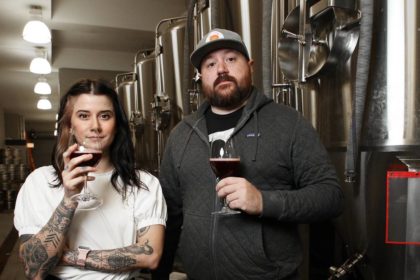
Dubbed the craft beer capital of America, Chicago has a brewery scene that is innovative and diverse. Numerous breweries have opened over the last decade, with now about 160 breweries across the city and surrounding suburbs. Ferment Magazine says Chicago’s craft brew industry is “one of the most expressive and most exciting experiences anywhere in the world, let alone in the U.S.”
“We have a very strong culinary scene in Chicago and a lot of consumers that have an open mind. There’s a lot we could throw at the market and people are very accepting of the different brewing styles, both old world and new world,” says Tyler Davis, founder and director of fermentation at Duneyrr Artisan Fermenta Project. “Of all the [different beer styles] we could produce, there are brewers in Chicagoland that specialize in that.”
Chicago’s Brewers
Duneyrr (pictured) focuses on co-fermentation. Using craft beer as a base, Davis makes fermented drinks with ingredients from wine, cider and mead.
“It all came from me reaching the end of my creativity in a brewery. I got tired of creating the same format,” says Davis, who worked in Chicago as head brewer at Lagunitas and at Revolution Brewing. He began experimenting with co-fermentation and found “how you ferment wine is shockingly similar to beer. There are nuances of both, but I enjoy blurring the lines.”
The Nordic-inspired drinks he produces include his favorite, Freya Franc,(a sour hybrid with passion fruit and Sauvignon Blanc grape must. Duneyrr also has a Moderne Dune line, a sister brand that specializes in modern ingredients and techniques.
Davis studied at the Chicago-based Siebel Institute of Technology, the oldest brewing school in the U.S. and alma mater to many area brewers. One alum is Dave Bleitner, who founded Off Color Brewing with his Siebel classmate, John Laffler. The two focus on funky fermentation.
“Even with our first flagship gose, Troublesome, we have always been fermentation-focused. Even when we are dumping in a bunch of rooibos tea and pumpkin pie spices into a beer, we believe beer needs a proper fermentation to work,” Bleitner says. “Maximizing flavor from yeast is always going to result in a superior beer. But beyond our focus on fermentation, we are not afraid to dump a bunch of rooibos tea and pumpkin pie spices into a beer. So the dual concepts of focusing on the basics of fermentation while teetering on the border of innovative and insane is something no one else should or can replicate.”
When Off Color launched in 2013, Bleitner and Laffler didn’t want to go the mainstream craft beer route. “We had some crazy idea that craft beer consumers wanted variety from their beer,” Bleitner said. They didn’t follow the usual craft beer formula of launching with an IPA. They started with lesser-known styles like gose and kottbusser. He notes “we really hit our stride with Apex Predator Farmhouse Ale.”
At 15 years old, Half Acre Beer is one of Chicago’s pioneers of the craft beer scene. The brewery is the third-largest independent brewer in Illinois and now distributes their beer all over the country. They run a brewery and taproom in Chicago. Their best seller is Daisy Cutter pale ale, but they also sell seasonal and monthly varieties.
“These days we’re kind of the older, bigger brewery among the smaller, newer breweries. We focus on hop-forward and traditional beers,” said Gabriel Magliaro, president of Half Acre. He echoed the sentiment expressed by Duneyyr and Off Color – Chicago brewers are a supportive community. “Today I think we can call Chicago a beer town and, no matter how you choose to define that, we show up well.”
The Next Beer Buzz
Craft beer brewers see increasing competition from the better-for-you, healthier fermented drinks, like kombucha, seltzer and low- or non-alcoholic beverages.
Duneyrr is starting to specialize in lower-alcohol fermented brews. Off Color, too, has added a lower-alcohol beer, a 2.5% ABV Belgian-style they call Beer for Lightweights.
Lagers are making a comeback as well. “A lot of old world brewing styles, there’s become a renaissance,” Davis says. He sees “candy beers” – filled with artificial flavors – going away. Bleitner, too, is not a fan – he calls hard seltzers “fermented pixie sticks”. But he’s found that consumers like flavor in their brews. When sales of Off Color’s Troublesome gose began to decline, adding lime juice revived the drink. They called it Beer for Tacos and “it took off almost immediately.”
In an era fraught with pandemic shutdowns, retail inflation and supply chain issues, brewers foresee challenges ahead.
“Obviously the pandemic has been a factor, one that is still playing out,” Magliaro says. “The on-premise was rocked and I don’t think anyone knows how that will look in five years.”
Climate change is affecting grain crops, “things we knew to be stable are now being highly influenced by the weather patterns,” Davis says. The hot weather is changing the nutrient level of grains, leading to grains higher in protein. “It’s pretty scary,” he says.
But beer will always find a way to thrive.
“We make something embedded in human culture,” Magliaro says. “Beer is a gathering liquid that has place almost anywhere for almost any occasion with so much heritage to its being. The industry, consumer landscape and world can do what it needs, but beer will live on.”
